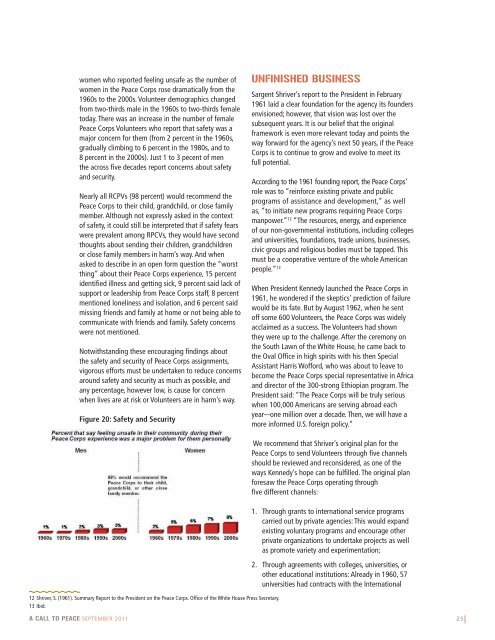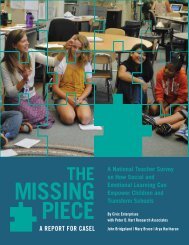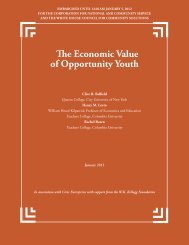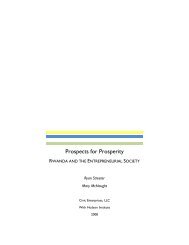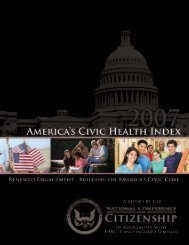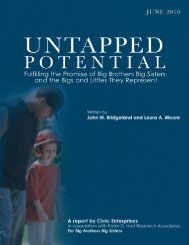A Call to Peace - Civic Enterprises
A Call to Peace - Civic Enterprises
A Call to Peace - Civic Enterprises
- No tags were found...
Create successful ePaper yourself
Turn your PDF publications into a flip-book with our unique Google optimized e-Paper software.
women who reported feeling unsafe as the number ofwomen in the <strong>Peace</strong> Corps rose dramatically from the1960s <strong>to</strong> the 2000s. Volunteer demographics changedfrom two-thirds male in the 1960s <strong>to</strong> two-thirds female<strong>to</strong>day. There was an increase in the number of female<strong>Peace</strong> Corps Volunteers who report that safety was amajor concern for them (from 2 percent in the 1960s,gradually climbing <strong>to</strong> 6 percent in the 1980s, and <strong>to</strong>8 percent in the 2000s). Just 1 <strong>to</strong> 3 pecent of menthe across five decades report concerns about safetyand security.Nearly all RCPVs (98 percent) would recommend the<strong>Peace</strong> Corps <strong>to</strong> their child, grandchild, or close familymember. Although not expressly asked in the contex<strong>to</strong>f safety, it could still be interpreted that if safety fearswere prevalent among RPCVs, they would have secondthoughts about sending their children, grandchildrenor close family members in harm’s way. And whenasked <strong>to</strong> describe in an open form question the “worstthing” about their <strong>Peace</strong> Corps experience, 15 percentidentified illness and getting sick, 9 percent said lack ofsupport or leadership from <strong>Peace</strong> Corps staff, 8 percentmentioned loneliness and isolation, and 6 percent saidmissing friends and family at home or not being able <strong>to</strong>communicate with friends and family. Safety concernswere not mentioned.Notwithstanding these encouraging findings aboutthe safety and security of <strong>Peace</strong> Corps assignments,vigorous efforts must be undertaken <strong>to</strong> reduce concernsaround safety and security as much as possible, andany percentage, however low, is cause for concernwhen lives are at risk or Volunteers are in harm’s way.Figure 20: Safety and SecurityUNFINISHED BUSINESSSargent Shriver’s report <strong>to</strong> the President in February1961 laid a clear foundation for the agency its foundersenvisioned; however, that vision was lost over thesubsequent years. It is our belief that the originalframework is even more relevant <strong>to</strong>day and points theway forward for the agency’s next 50 years, if the <strong>Peace</strong>Corps is <strong>to</strong> continue <strong>to</strong> grow and evolve <strong>to</strong> meet itsfull potential.According <strong>to</strong> the 1961 founding report, the <strong>Peace</strong> Corps’role was <strong>to</strong> “reinforce existing private and publicprograms of assistance and development,” as wellas, “<strong>to</strong> initiate new programs requiring <strong>Peace</strong> Corpsmanpower.” 12 “The resources, energy, and experienceof our non-governmental institutions, including collegesand universities, foundations, trade unions, businesses,civic groups and religious bodies must be tapped. Thismust be a cooperative venture of the whole Americanpeople.” 13When President Kennedy launched the <strong>Peace</strong> Corps in1961, he wondered if the skeptics’ prediction of failurewould be its fate. But by August 1962, when he sen<strong>to</strong>ff some 600 Volunteers, the <strong>Peace</strong> Corps was widelyacclaimed as a success. The Volunteers had shownthey were up <strong>to</strong> the challenge. After the ceremony onthe South Lawn of the White House, he came back <strong>to</strong>the Oval Office in high spirits with his then SpecialAssistant Harris Wofford, who was about <strong>to</strong> leave <strong>to</strong>become the <strong>Peace</strong> Corps special representative in Africaand direc<strong>to</strong>r of the 300-strong Ethiopian program. ThePresident said: “The <strong>Peace</strong> Corps will be truly seriouswhen 100,000 Americans are serving abroad eachyear–-one million over a decade. Then, we will have amore informed U.S. foreign policy.”12 Shriver, S. (1961). Summary Report <strong>to</strong> the President on the <strong>Peace</strong> Corps. Office of the White House Press Secretary.13 Ibid.We recommend that Shriver’s original plan for the<strong>Peace</strong> Corps <strong>to</strong> send Volunteers through five channelsshould be reviewed and reconsidered, as one of theways Kennedy’s hope can be fulfilled. The original planforesaw the <strong>Peace</strong> Corps operating throughfive different channels:1. Through grants <strong>to</strong> international service programscarried out by private agencies: This would expandexisting voluntary programs and encourage otherprivate organizations <strong>to</strong> undertake projects as wellas promote variety and experimentation;2. Through agreements with colleges, universities, orother educational institutions: Already in 1960, 57universities had contracts with the InternationalA CALL TO PEACE SEPTEMBER 201125|


